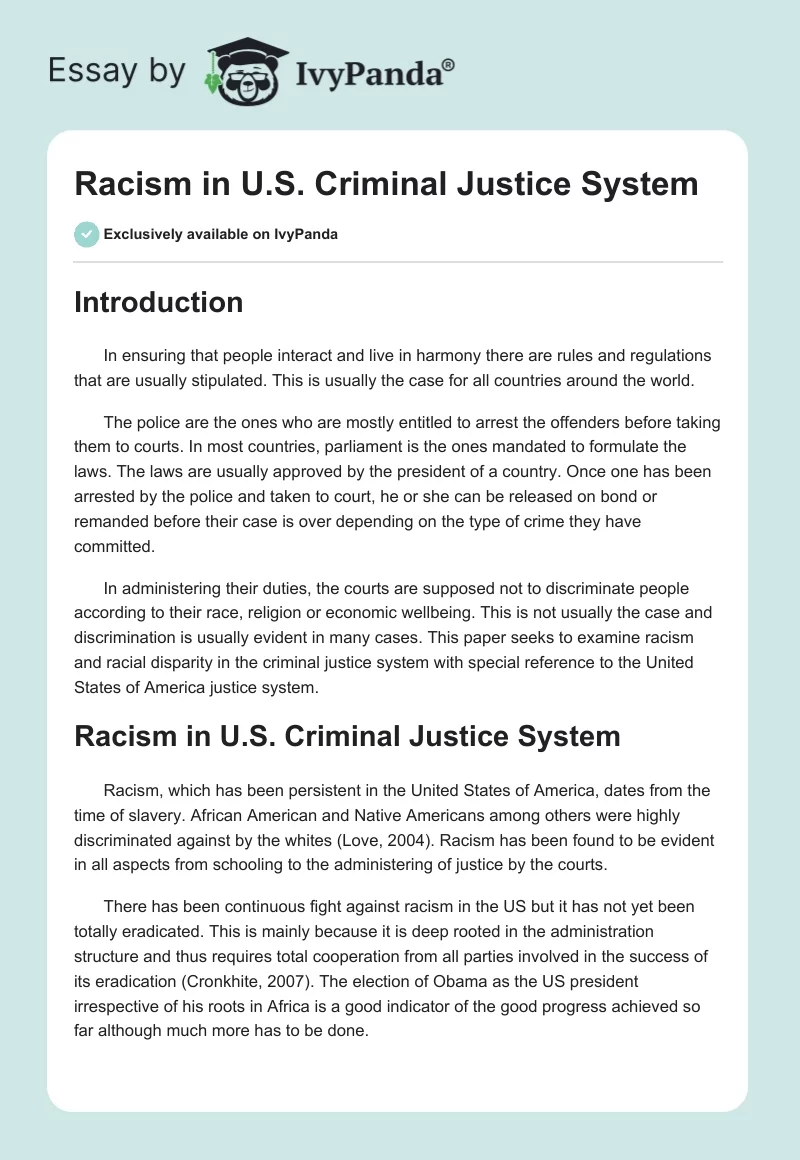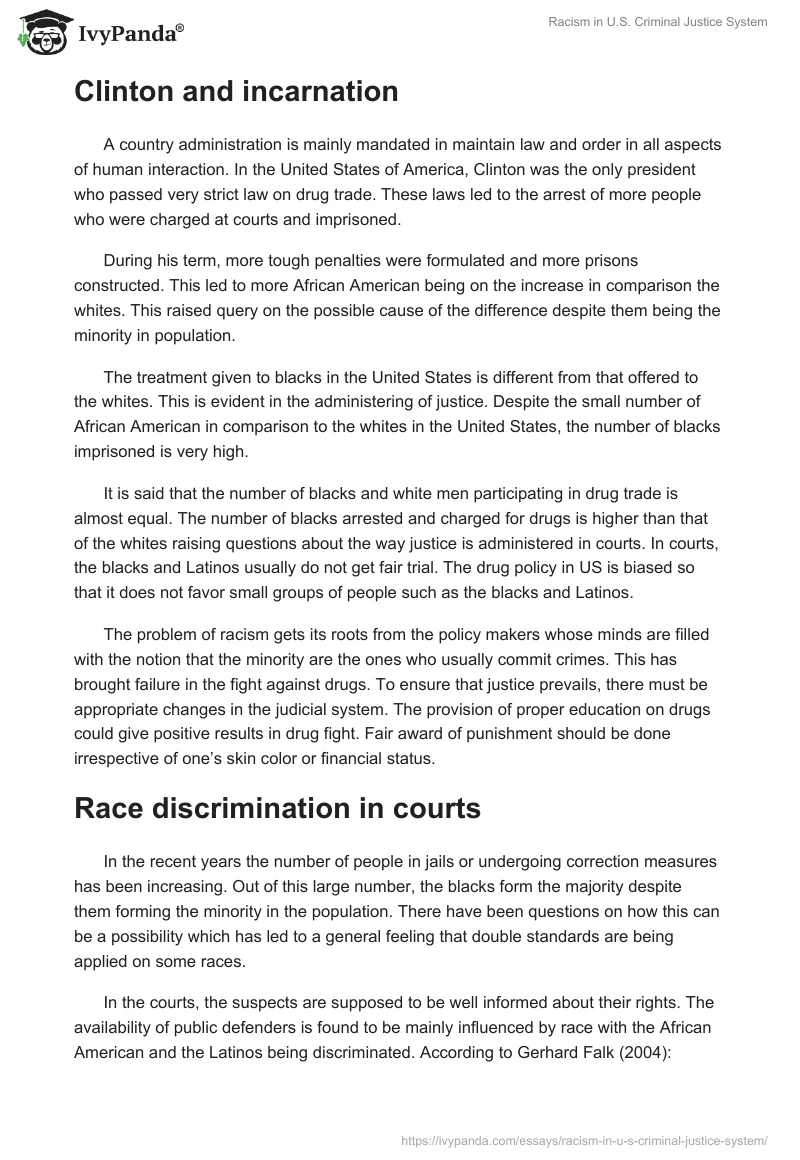Introduction
In ensuring that people interact and live in harmony there are rules and regulations that are usually stipulated. This is usually the case for all countries around the world.
The police are the ones who are mostly entitled to arrest the offenders before taking them to courts. In most countries, parliament is the ones mandated to formulate the laws. The laws are usually approved by the president of a country. Once one has been arrested by the police and taken to court, he or she can be released on bond or remanded before their case is over depending on the type of crime they have committed.
In administering their duties, the courts are supposed not to discriminate people according to their race, religion or economic wellbeing. This is not usually the case and discrimination is usually evident in many cases. This paper seeks to examine racism and racial disparity in the criminal justice system with special reference to the United States of America justice system.
Racism in U.S. Criminal Justice System
Racism, which has been persistent in the United States of America, dates from the time of slavery. African American and Native Americans among others were highly discriminated against by the whites (Love, 2004). Racism has been found to be evident in all aspects from schooling to the administering of justice by the courts.
There has been continuous fight against racism in the US but it has not yet been totally eradicated. This is mainly because it is deep rooted in the administration structure and thus requires total cooperation from all parties involved in the success of its eradication (Cronkhite, 2007). The election of Obama as the US president irrespective of his roots in Africa is a good indicator of the good progress achieved so far although much more has to be done.
Clinton and incarnation
A country administration is mainly mandated in maintain law and order in all aspects of human interaction. In the United States of America, Clinton was the only president who passed very strict law on drug trade. These laws led to the arrest of more people who were charged at courts and imprisoned.
During his term, more tough penalties were formulated and more prisons constructed. This led to more African American being on the increase in comparison the whites. This raised query on the possible cause of the difference despite them being the minority in population.
The treatment given to blacks in the United States is different from that offered to the whites. This is evident in the administering of justice. Despite the small number of African American in comparison to the whites in the United States, the number of blacks imprisoned is very high.
It is said that the number of blacks and white men participating in drug trade is almost equal. The number of blacks arrested and charged for drugs is higher than that of the whites raising questions about the way justice is administered in courts. In courts, the blacks and Latinos usually do not get fair trial. The drug policy in US is biased so that it does not favor small groups of people such as the blacks and Latinos.
The problem of racism gets its roots from the policy makers whose minds are filled with the notion that the minority are the ones who usually commit crimes. This has brought failure in the fight against drugs. To ensure that justice prevails, there must be appropriate changes in the judicial system. The provision of proper education on drugs could give positive results in drug fight. Fair award of punishment should be done irrespective of one’s skin color or financial status.
Race discrimination in courts
In the recent years the number of people in jails or undergoing correction measures has been increasing. Out of this large number, the blacks form the majority despite them forming the minority in the population. There have been questions on how this can be a possibility which has led to a general feeling that double standards are being applied on some races.
In the courts, the suspects are supposed to be well informed about their rights. The availability of public defenders is found to be mainly influenced by race with the African American and the Latinos being discriminated. According to Gerhard Falk (2004):
The bureau of justice statistics reported in 2008 that in 2007 there were 4618 black males sentenced to prison for violent crimes for every 100,000 black male citizens. This number compares to 1,747 Hispanic males and 773 Euro-American males per 100,000 in the population. Since the African American population is only 13 percent of all Americans and the Hispanic population is just 12 percent of all Americans, there is indeed a great overrepresentation of blacks and Hispanics in our prisons. (Falk 2)
The issue of racism in the US criminal justice system is evident in all its levels. This stems down from the judges offering at the courts to the way the police interact with the citizen (Young, Greene and Gabbidon 153). It has been shown that the police interact with the whites better than with the blacks.
This is evident through the large number of blacks and Latinos being stopped and frisked in comparison to the whites. Over the years it has been observed that the probability of a black man being stopped and frisked is much higher than that of the white. In all these cases, the male is usually at higher chances of being harassed by the police than the females.
The judges depend on the law in administering justice. In courts, there are groups of people who are usually mandated by the court to argue a case from facts. In the US, there has been discrimination in the administration of jury services to the African Americans. This indicates a big failure in the judicial system in administering justice to all.
According to the law, any person is entitled to undergo a trial before they are sentenced by the court. A large number of African Americans usually do not get tried in accordance with the constitution in fear of being given heavier penalties on the crimes committed.
Recommendation
Generally speaking it is possible that most of the colored and black people get involved in committing crimes due to their financials status. Most of them might not have some means of livelihood and therefore as a means of sustaining themselves they resort to criminal and criminal related activities. The government should find a solution to empower these people instead of passing strict laws on drugs. By empowering this population, the problem of drug trafficking would have been solved automatically.
Conclusion
The racial discrimination in the US is observed as a way of social control. The issue of overlooking the African American and the Latinos as criminals has been used as a great weapon in the discrimination. This could be viewed as an internal war on the marginalized. The main reason behind all these is dominance by the whites in almost all the organs of justice.
The best way of overcoming this problem is through intensive revolution of values. This thus requires looking into the root cause of the problem and finding the best way to handle the situation. Increasing the number of prisoners in our jail does not ensure our security but a better approach should be undertaken.
Works Cited
Cronkhite, Clyde. Criminal justice administration: strategies for the 21st century. Massachusetts: Jones & Bartlett Learning, 2007. Print.
Falk, Gerhard. The American criminal justice system: how it works, how it doesn’t, and how to fix it. California: ABC-CLIO, 2010. Print.
Love, Eric. Race over empire: racism and U.S. imperialism, 1865-1900. North Carolina: UNC Press Books, 2004. Print.
Young, Vercetta., Greene, Helen and Gabbidon, Shaun. African American classics in criminology & criminal justice. California: SAGE, 2002. Print.


